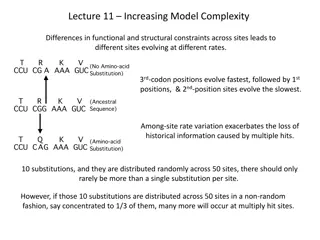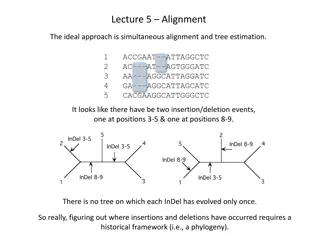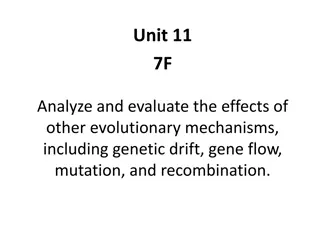Evolution and Plant Systematics Lecture Overview
This lecture outline delves into the concepts of evolution, unity, and diversity of organisms on Earth, covering topics such as fossils, Lamarck and Darwin's theories, adaptation, natural selection, artificial selection, Carolus Linnaeus' systematics, plant evolution, and the demonstration of evolut
5 views • 26 slides
Evolutionary Models in Molecular Biology
Differences in functional and structural constraints across sites lead to varying rates of evolution in molecular sequences. Understanding the complexities of site-specific rates, among-site rate variation, site-specific rates models, invariable sites model, and continuous methods is crucial for acc
6 views • 15 slides
Phylogenetic Status of Peripatus: Exploring its Systematic Position
Peripatus, known as claw bearers, exhibits characteristics of both annelids and arthropods, making it an intriguing species in the study of evolutionary biology. Considered as an intermediate link between these two phyla, Peripatus raises questions about its classification and evolutionary history.
0 views • 10 slides
Understanding Phylogeny and Evolution in Angiosperms
Phylogeny is the study of evolutionary relationships among organisms, depicted in phylogenetic trees based on shared characteristics. This overview delves into terms like homology, analogy, monophyly, and co-evolution in angiosperms with an emphasis on taxonomy, systematics, and the evolutionary his
1 views • 25 slides
Understanding Cladograms and Phylogenetic Analysis
Cladograms are used in cladistics to illustrate evolutionary relationships between organisms based on shared ancestral and derived characters. They are created by grouping species by common descent, forming clades that include an ancestral species and all its descendants. Valid clades are monophylet
0 views • 11 slides
Understanding Evolutionary Mechanisms: Natural Selection, Genetic Drift, and Gene Flow
Exploring the forces behind evolutionary change, this content delves into natural selection, genetic drift, and gene flow. Examples such as the bottleneck effect, founder effect, and Amish population polydactylism are presented to illustrate how these mechanisms shape genetic diversity. The impact o
0 views • 14 slides
Evolutionary Insights of Basidiomycota Dikaryons
Basidiomycota, a successful fungal group with 30,000 known species, predominantly exhibits filamentous vegetative growth while also producing yeast forms. The multi-layered cell wall and regularly septate hyphae with dikaryotic mycelium are key characteristics. Recent experimentation on Schizophyllu
0 views • 20 slides
Understanding Speciation and Extinction in Evolutionary Biology
Explore the modes of speciation and causes of extinction in the evolutionary process. Learn how species evolve to become distinct through geographic isolation and reduced gene flow. Understand the implications of extinction and its impact on biodiversity. Images and descriptions provided offer insig
0 views • 33 slides
Fundamentals of Taxonomy Explained: From Classification to Nomenclature
Taxonomy, derived from Greek roots, encompasses the science of classifying organisms and understanding their variations, evolutionary relationships, and naming conventions. It involves description, identification, classification, and nomenclature of both living and extinct organisms. The practices o
1 views • 39 slides
Evolutionary Sociology Seminar: Exploring Human Behavior Through Interdisciplinary Perspectives
This seminar at the University of Zurich, led by Prof. Sebastian Schnettler, delves into the realm of evolutionary sociology, examining the impact of genetics, hormones, and social processes on human behavior. The course integrates biology and sociology, offering a variety of approaches to understan
0 views • 11 slides
Evolutionary Trends in Monera Kingdom: Archaebacteria, Eubacteria, and Actinomycetes
Monera, the simplest yet diverse kingdom, is divided into Archaebacteria and Eubacteria. Archaebacteria are ancient, thriving in extreme conditions, while Eubacteria encompass true bacteria with various metabolic capabilities. Actinomycetes, unique filamentous bacteria, play vital roles in soil ecos
0 views • 4 slides
Insights into Evolutionary Adaptation and Genetic Variation
The production order highlights the essential role of genomic variation as fuel for natural selection, driving evolutionary adaptation. The Cambrian Explosion timeframe reveals a rapid increase in evolutionary adaptation, showcasing the appearance of diverse animal phyla over a relatively short peri
5 views • 6 slides
Analyzing the Development of Theme in Stories
Analyzing the development of a theme involves breaking down the story into its literary elements such as characters, plot, and setting to understand how the theme evolves and is conveyed throughout the narrative. By examining how these elements contribute to the overall message or lesson about life
0 views • 22 slides
Understanding Biosystematics and Its Significance in Biological Classification
Biosystematics plays a crucial role in refining biological classification by focusing on biological criteria to define relationships within closely related species. It helps delineate biotic communities, recognize different biosystematic categories, and understand evolutionary patterns. Through the
0 views • 15 slides
Exploring Human Origins: Evolution and Phylogenetic Trees
Delve into the fascinating realm of human origins through an examination of humans and African apes, evidence for evolution, and the construction of phylogenetic trees. Understand the relationships between species, common ancestors, and key evolutionary developments that have shaped the course of hu
4 views • 18 slides
Insights into Sexual Selection and Speciation in Evolutionary Biology
Explore the fascinating concepts of sexual selection, sex differences, and speciation in evolutionary biology through topics such as ornamentation in males, survival advantages, and the influence of mate preferences on offspring fitness. Dive into the mechanisms that drive the evolution of species a
0 views • 26 slides
Progressive Alignment Overview in Phylogenetics
In the field of phylogenetics, the process of progressive alignment is crucial for aligning sequences and building evolutionary trees. This approach involves generating pairwise alignments, estimating distances, constructing guide trees, and aligning sequences progressively based on the tree. Needle
0 views • 12 slides
Celebrating Black History Month: Theme, People, & Activities
Black History Month is a time dedicated to celebrating the achievements of Black individuals past and present, highlighting the need for equality and recognition of Black history. This year's theme, "Time for Change: Action Not Words," encourages active participation in combating racism and promotin
0 views • 13 slides
Computing Triplet and Quartet Distances Between Evolutionary Trees
Study on computing triplet and quartet distances in evolutionary trees, comparing rooted vs. unrooted, binary vs. arbitrary degree trees. Discusses algorithms, experimental results, and evolutionary tree construction methods. Includes analysis on cultural phylogenetics and evolutionary tree comparis
0 views • 27 slides
Evolutionary Dynamics in Signaling Games and Strategies
Explore the intricate dynamics of signaling games and evolutionary strategies like Lewis signaling games, Hamilton Maynard Smith theories, and replicator dynamics. Witness the evolution of signaling strategies through simulations and understand the role of replicator dynamics in population interacti
1 views • 50 slides
Evolutionary Insights from the Ordovician Period
The Ordovician period was marked by significant events such as the average temperature and atmospheric CO2 levels, the emergence of diverse life forms, glacial events leading to mass extinctions, and the survival of the fittest in evolving environments. Primitive reefs, major evolutionary radiation
0 views • 12 slides
Understanding Co-evolution: A Closer Look at the Red Queen Hypothesis in Biology
Co-evolution refers to the reciprocal genetic changes in species in response to each other. The Red Queen Hypothesis, illustrated in the arms race between parasites and hosts, exemplifies this phenomenon. This interaction drives evolutionary dynamics in herbivores, plants, pollinators, prey, predato
0 views • 18 slides
Exploring The Great Controversy Theme in Adventist Theology
Delve into the core concept of the Great Controversy Theme, a foundational doctrine in Adventist Theology. This theme serves as a stronghold against the influences of emerging church movements, focusing on the contrasting principles of Creationism and Creature-Centered Reason/Feeling. It reflects th
0 views • 117 slides
Understanding Taxonomy and Classification in Biology
Scientists use classification to group organisms logically, making it easier to study life's diversity. Taxonomy assigns universally accepted names to organisms using binomial nomenclature. Carolus Linnaeus developed this system, organizing organisms into species, genus, family, order, class, phylum
0 views • 11 slides
Exploring Evolutionary Mechanisms: Genetic Drift, Gene Flow, Mutation, and Recombination
Delve into the effects of evolutionary mechanisms such as genetic drift, gene flow, mutation, and recombination in populations. Understand how changes in allele frequencies occur due to various factors like natural disasters and the bottleneck effect, impacting the gene pool and future generations.
1 views • 32 slides
Evolutionary Pioneers: Anning, Darwin, Wallace - Key Figures in Evolutionary Theory
Meet the evolutionary pioneers - Mary Anning, Charles Darwin, and Alfred Russel Wallace, who played crucial roles in the development of evolutionary theory. Learn about their groundbreaking discoveries, challenges faced, and lasting impact on the scientific community.
0 views • 7 slides
NILOA 2020 Theme: Striving for Improvement in Various Aspects
The National Intercollegiate Lacrosse Officials Association (NILOA) has set the theme for 2020 as striving for improvement. The theme encompasses various areas such as flight scheduling, director calls to bring light to current issues, forum questions for consistency, new membership processes, rule
0 views • 20 slides
Exploring Evolutionary Trees and Family Lineages
Dive into the world of evolutionary trees and family lineages through captivating visuals and informative illustrations. Explore the relationships between species, understand genetic connections, and discover how traits evolve and spread through generations. From evolutionary history to family trees
0 views • 25 slides
Comparative Analysis of Evolutionary Parameters in Giraffe and Okapi Vision Genes
This presentation compares three evolutionary parameters (dN, dS, dN/dS) between giraffe and okapi in a set of vision genes using the free-ratio model of the PAML program. The images illustrate the differences in nonsynonymous and synonymous substitutions, as well as the ratio of nonsynonymous to sy
0 views • 4 slides
Understanding Aggression: Exploring Its Evolutionary Roots
Delve into the complexities of human aggression, questioning whether it is inherent or a learned behavior. Explore evolutionary theories and biological perspectives on the causes of aggression, examining how factors such as genetics, brain structures, hormones, and environmental pressures may influe
0 views • 11 slides
Understanding Evolutionary Theories and Strategies
Exploring evolutionary theories such as Sexual Selection Theory and Gene Selection Theory sheds light on how characteristics evolve for mating advantage. Insights into intersexual and intrasexual competition offer a deeper understanding of mate selection preferences. Gene selection mechanisms influe
0 views • 20 slides
Exploring Human Origins Through Hominid Fossils and Evolutionary Traits
Delve into the fascinating world of human origins, examining hominid fossils, anatomical traits, and evolutionary evidence. Learn about early species like Ardipithecus ramidus, differentiate African apes from modern humans, and analyze the genetic lineage supporting human evolution. Explore tables,
0 views • 14 slides
2016 Annual Theme: The Biblical Context - God's Command to Be Fruitful and Multiply
Delve into the 2016 annual theme centered around Genesis 1:26-28 and explore the concept of being fruitful and multiplying as a command from God. The theme emphasizes growth, productivity, abundance, and success, drawing inspiration from biblical teachings. Through key points and scriptural referenc
0 views • 13 slides
GCSE English Literature: An Inspector Calls - Social Responsibility Theme Analysis
In this GCSE English Literature mock exam paper, students will analyze the theme of social responsibility in the play "An Inspector Calls." The question focuses on exploring this theme with reference to the context of the play while incorporating key elements like interpretations, use of quotations,
0 views • 12 slides
Understanding Dichotomous Keys and Cladograms in Evolutionary Biology
Dichotomous keys are utilized to classify different organisms based on their physical characteristics, while cladograms depict evolutionary relationships. Derived traits play a crucial role in understanding evolutionary history, indicating features present in later organisms but not earlier ones. Pr
0 views • 16 slides
Exploring Theme Seeds to Themes and Chapter Reviews in To Kill a Mockingbird
Dive into building theme statements by progressing from theme seeds, analyzing themes in chapters, and preparing presentations. Understand the significance of theme statements and their relation to the author's beliefs, as depicted in the novel To Kill a Mockingbird, culminating in a comprehensive e
0 views • 12 slides
Rotary International President Elect Theme - Be a Gift to the World by K.R. Ravi Ravindran
Inspiring theme by Rotary International President Elect, K.R. Ravi Ravindran, encourages members to be a gift to the world by utilizing their talents and gifts to promote Rotary and make a positive impact on communities. The theme highlights Rotary's achievements in eradicating polio, providing aid,
0 views • 8 slides
Understanding Phylogenomics and Gene Function Prediction in Evolutionary Biology
Explore the significance of phylogenomics in predicting gene functions and establishing evolutionary relationships using genome-scale data. Learn about the challenges of using single genes or a few genes in phylogenetic analysis, the importance of analyzing multilocus data, and the need for multiple
0 views • 24 slides
Discovering Ideal Designer Wedding Gowns for Your Unique Theme and Aesthetic
Your wedding dress should match the theme and your style. With so many patterns, materials, and designers, choosing may be hard. Understanding how to match your gown to your style and celebration theme simplifies the process. Visit us to know more!
2 views • 8 slides
Analyzing Language, Structure, and Theme in Poetry
Understanding how language, structure, and form contribute to the creation of a theme in poetry is essential. This process involves analyzing literary devices, imagery, shifts in mood, stanza patterns, and the overall message conveyed by the poet. By asking specific questions related to language, st
1 views • 7 slides







































